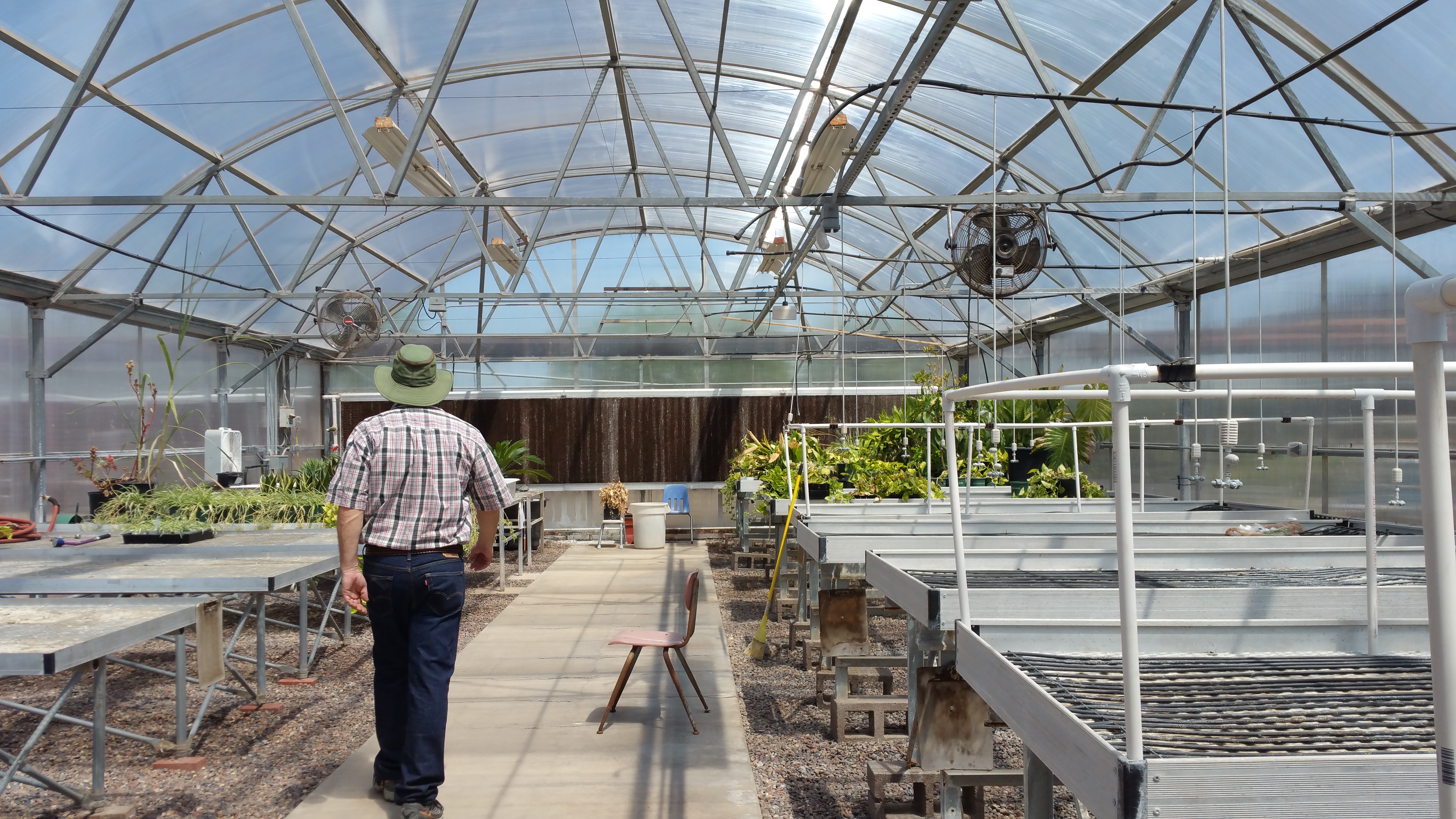Interview with Peter Condon of MCC Center for Urban Agriculture Where Students Learn to Farm Using Sustainable Agriculture Methods
Kari: I’m here with Peter Condon and Christee Rothbard at the Mesa Community College Center for Urban Agriculture, where students can learn to farm successfully and profitably. We are here to take a tour of the amazing teaching farm and talk to them about the sustainable agriculture methods that they are teaching the students, community gardens and farmers markets that they are working on with the people that go to school here, as well as some personal (projects.)
Christee Rothbard
Kari: Christee, you are renting some land in Casa Grande and growing some food? Tell me a little bit about that.
Christee: I have more livestock than I have plants because the summer has been kind of brutal. But, a lot of herbs, ducks, chickens, goats, a turkey that will probably be thanksgiving dinner. Other than that, landscape stuff, too.
Kari: That’s awesome. Did you rent it with the idea that you wanted to do urban farming? Or were you renting just for a place to live and then got into it?
Christee: It’s evolving in the sense that we moved from Gilbert to New Mexico for three years for my husband’s work. And while we were in New Mexico, I decided to get a couple goats and more chickens. So when we moved back here, we needed more land. Casa Grande is a lot cheaper for land. We have just shy of 2 acres at 1.98. And then we have horses, so there’s that, but just to have room. It’s cheaper, and my landlord is ridiculously lenient. She lets me grow and bring home whatever I want, pretty much.
The Role of a Land Lab Technician at the MCC Farm
Kari: And what is your role here at MCC in the urban farming program? How to you help the students learn to farm?
Christee: I’m a land lab technician. I make sure things stay alive. Water, propagate plants for any instructors and make sure the fish stay alive in the aquaponics system, as well.
Kari: Challenging with our weather right now, for the fish and the plants! This is August in Phoenix. It’s like growing things on the surface of the sun, so if you see some brown things around, that’s why. But most everything under this cover looks really nice and green, so it’s looking good. These pomegranates look really nice. So, Peter, tell me about your role at MCC.
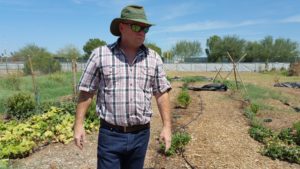 Urban Farming Programs at MCC
Urban Farming Programs at MCC
Peter: I’m the Program Director for Urban Agriculture and Sustainable Agriculture…Urban Horticulture, sorry. Our Sustainable Agriculture program is brand new. That will be on the books for the spring. It will be going through the curriculum committee next month. And my role here is to listen to what people need and want in the community and provide them with courses.
One of the challenges this time of year is that this is the first day of classes, and this whole place is run by students and teachers. So when the students and teachers aren’t here, everything goes you-know-where in a hand basket. So we’re trying to get things up and running. Thanks to Christee and a couple of volunteers, we’ve got our little pomegranate cuttings that the students did last semester. They’re still doing well.
So, we grow plants here. We sell them at our plant sales and our farmer’s markets. And the produce that we grow, whatever we don’t sell, we give to the local food banks. So that’s an added bonus to working here is that not only do we offer courses, but we’re also helping the community, which really makes me feel good.
Community Gardens and Farmers Markets at MCC
Kari: When students learn to farm at MCC, they also learn how to run a farm business. Tell me about the community garden. Is that where you have your farmers market?
Peter: Our market is held in the central campus. We tried it out here, but we’re pretty much out in the hinterlands. So, people don’t just walk by. We will get the people who come here intentionally, but don’t get just the walk-bys. We’re teaching the students to be urban farmers. An urban farmer, most times, is going to grow a crop and take it to a farmer’s market or some central place for sale. So, their getting all the experience. They’re growing it, harvesting it, cleaning it, and then getting it ready to go.
Tour of MCC Teaching Gardens and Teaching Farm Plots
Peter: Where you’re standing right now, these are the teaching gardens for our introductory organic gardening class. This is a product of what’s survived over the summer, so you’ll see some very mature sunflowers, some Bermuda grass over there, and then a lot of tomatoes that are sort of lying down. And when you lift them up, there are some really good looking tomatoes on the bottom. Tomatoes in nature are ramblers, so if you don’t tie them up in the desert, let them ramble. They’re going to do great. You can tie them up just to look better, it’s easier to harvest. But in the summertime, they just go away because it’s too hot.
Kari: Either the sun gets them, or the birds.
Peter: The sun gets them, the birds get them, the pollen dries up so the flowers aren’t viable. And we’ve got a small citrus orchard over here that’s not really part of a class right now. But we maintain that. We mainly donate that fruit for people on staff, so that’s a little added perk for working here.
Hardening Off
So, as part of the ornamentals, this is our hardening off area. So we pot these plants in the greenhouse, and we bring them out here to harden them off. Here’s some sour oranges, and this is understock for our citrus grafting program.
Kari: So (these are) like a root stock?
Peter: Yes, this is the root stock and they will be probably a little bit thin for this year. But we’ll see what we can do with them. I also teach plant propagation. So we’ll be, hopefully, budding some citrus onto these guys this semester.
Kari: And you use the sour orange because it’s a hardier?
Peter: The rootstock is more adapted to the harsh climates out here. And we’ve got some Moringa growing here. (Peter tastes a leaf.) These are all food projects.
Aquaponics, Water Conservation and Sustainable Agriculture
Peter: We have an aquaponics course at the college. So, we’ve got three teaching systems. They’re smaller scale systems that you could potentially do at home.
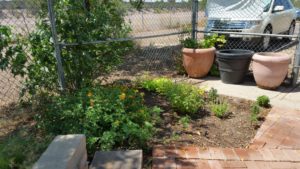 Peter: Please bear in mind, this is at the end of the summer. No students and no teachers have been here all summer.
Peter: Please bear in mind, this is at the end of the summer. No students and no teachers have been here all summer.
Kari: We’ll have to come back later in the fall and get some pictures to update.
Peter: So, tonight in class, the professor, Dr. George Books, will be moving all these plants with the students and replanting them. So this will look great in a couple of weeks.
Here are some beets that have sort of made their way through the summer, so you can grow beets in an NFT aquaponics system.
Kari: Is this celery?
Christee: Yep, celery, alfalfa, goldfish…
Talapia in the Aquaponics System
Peter: There are tilapia in the big tank, here. And we’ve got some good algae growing in the deep water culture. We’re going to clean this all up and replant it. And then there is the media bed over there, which has been the most successful over the summer. That has received virtually no care, other than Christee topping off the water and checking the pH. We’ve got sugar cane growing in here. There’s mint. Mint loves the media bed.
Kari: Beets?
Peter: Beets we’re growing in here.
Christee: Malabar spinach.
Media Beds
Peter: In the media bed system, you can probably grow the widest variety of plants in this system of aquaponics. It more closely replicates a natural soil system. So, you’ve got a pile of gravel and a constantly recirculating water system, so there’s plenty of water. It drains out the bottom. The nutrients get spread throughout.
Kari: Is this all gravel, all the way down (to the bottom of the bed?)
Peter: Yes, all the way down. This weighs probably 3,000 pounds, so don’t kick it.
Kari: (LAUGHS) You wouldn’t want it to fall on you!
Peter: And you’ve got a really good colony of bacteria in there that convert the ammonia from the fish and make (nitrates from the fish waste for the plants to pick up.) The plants absorb the nitrates and send fairly clean water back to the fish.
Settling Tank
Kari: Is this a filter?
Peter: This is a settling tank where the solids settle out. And then the water goes through here (pointing to a pipe,) minus the solids and gets pumped into the media tank. And then it gets pumped right back this way (pointing to a pipe leading to a tank.) And then, these are our tilapia.
Talapia love to eat, so we’ve got them out here. We just put in some new fry a couple of weeks ago. So I figure in 3 or 4, 5 months maybe, we’ll have (lots more) tilapia.
Kari: How many can live in this tank?
Peter: I am not an aquaponics expert, so I’m going to a lot…more than five and less than 1,000.
Kari: They can jump out, right?
Peter: They jump out. Talapia are jumpers. Talapia are from North Africa, kind of a harsh area, so they’re more adapted to low-oxygen [INAUDIBLE.]…Let’s take a walk out here.
Learn to Farm Using Small Equipment
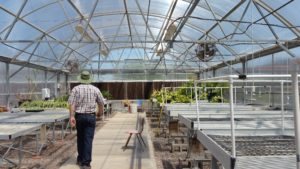 So, as an urban farmer, you really don’t need big equipment here. We used to have an agronomy program here, years ago. So we had some pretty big tractors. That old International, that’s the biggest one we have. But, we’ve got some smaller tractors. For an urban farmer who’s just working the backyard, maybe an acre, or two or three acres, all you really need is a rototiller. You can share that with someone else or rent it. A pitchfork, and shovel, and a strong back.
So, as an urban farmer, you really don’t need big equipment here. We used to have an agronomy program here, years ago. So we had some pretty big tractors. That old International, that’s the biggest one we have. But, we’ve got some smaller tractors. For an urban farmer who’s just working the backyard, maybe an acre, or two or three acres, all you really need is a rototiller. You can share that with someone else or rent it. A pitchfork, and shovel, and a strong back.
Kari: Yeh, and maybe some friends (LAUGHS.)
Peter: Yeh, and some friends. Teenage kids help, too, because you can get them all over and bribe them to (do the work.)
Lewis: Local Boy Scout troops are a dandy.
Peter: Local Boy Scouts are great, too. We’ve actually had an Eagle Scout project at the community garden a couple years ago. So, they’re always looking for a project.
Greenhouse Growing and Growing Seasons
Peter: We are very blessed to have a greenhouse. If you can get a greenhouse at your property, that’s great. That really helps with getting a jump on winter starts and early spring starts.
Kari: So you can kind of get a jump on the season?
Peter: Yes.
Kari: Starting plants early is important. This is an important concept for people who are learning to farm, especially in Phoenix because our growing seasons are so compacted. We have so many different temperature ranges…
Growing Tomatoes in the Low Desert
Peter: So, if you want to get tomatoes ready for harvest before the freeze, you really want to have them pretty good size and already in the ground under shade. And once the sun intensity dies down, you can remove the shade, and you’ve got a plant that’s ready to produce. So you’ll have gained already a month or two.
Kari: And that’s one of the mistakes that people make when growing tomatoes in Arizona; they get their starts in too late, and then there’s not the right temperatures for fruiting.
Peter: Or, they get them in too early, but they don’t protect them. And then, they shrivel up in the heat and the sun or they won’t set pollen.
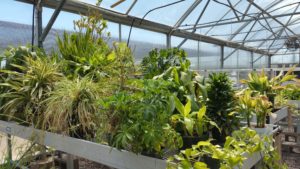 Kari: I put mine in in January and cover them. (Continued as we walk from the covered area out to the community garden)
Kari: I put mine in in January and cover them. (Continued as we walk from the covered area out to the community garden)
Community Garden
Peter: Here is our community garden, we call it the center of urban agriculture, that’s our new name and Christine’s right in front of the sign. In here we have got community garden plots and roughly just over an acre of area for us to farm, too. This is a good learning space for students who have maybe an acre of land or less, so that they can see how you can actually intensively grow crops in a small area, so let’s head on in. Once again we are at the end of the summer.
Hot Weather Gardening
Kari: It’s what, 107 (degrees) today? Something like that?
Peter: Yeah, it’s about 107. It’s been a pretty hot summer. The trouble with community gardens is people work their butts off all year long, then it gets so hot and they can’t come out in the summer. Then they come out after being away for two months and it’s covered in Bermuda grass and they get disgruntled.
The trick is, when it’s really hot like this, you get out before work. This is when you work in your soil, when it’s too hot to plant. Then when it comes planting time you don’t start from scratch getting all the weeds out. You can see a plot down there that looks like a lawn, and then there’s a plot here that someone’s been (solarizing.)
Solarizing
Peter: Yeah, so they’ve been working this. Getting ready for a planting in September.
Kari: Are they solarizing this or what’s the …
Peter: Yes.
Kari: They’re trying to get rid of Bermuda here?
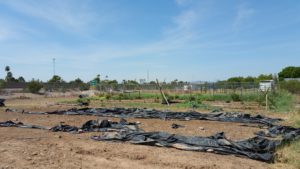 Peter: Over here we’ve got another gardener who’s solarizing their plot. They’ve had this black plastic on for probably two months now and they’re trying to let mother nature, through her solar generator, kill the Bermuda grass and theoretically kill any weed seeds that are in the weed bank in the soil. It takes a few months. It can work, but you have to remember that Bermuda grass is stoloniferous. If it’s alive there, once you take this off, those stolons can spread back in.
Peter: Over here we’ve got another gardener who’s solarizing their plot. They’ve had this black plastic on for probably two months now and they’re trying to let mother nature, through her solar generator, kill the Bermuda grass and theoretically kill any weed seeds that are in the weed bank in the soil. It takes a few months. It can work, but you have to remember that Bermuda grass is stoloniferous. If it’s alive there, once you take this off, those stolons can spread back in.
Kari: Come back, sure.
Peter: Gardening is constant vigilance. If you stay on top of it, you’ll have a great time. You can see that welcome sign over there, there’s no Bermuda grass over there because whenever they see one they pluck it out. Constant vigilance, it is not a once a month job.
Summer Gardening
Kari You have some eggplant here.
Peter: Eggplant does really well in the summer.
Kari: Basil.
Peter: Basil loves the summer heat, herbs do.
Kari: Like rosemary?
Peter: Rosemary’s a fantastic plant for the Mediterranean that loves this ground. Basil’s surprisingly [inaudible 00:03:16] transplant so when I moved out here basil to me would look like a tender plant, it just boomed through the summer.
Kari: It does, it doesn’t mind the heat at all. It looks like some kale maybe that’s kind of made it through.
Peter: You’ve got some old kale here. It’s probably got some …
Kari: Probably pretty bitter.
Peter: Aphids. No, it’s too hot for the aphids, and while it might not be too bitter I’m not seeing that white sap so it might not be too bad. It’s OK.
Organic Gardening
Kari: I’m assuming you’re growing organically here since you’re just eating stuff out of the …
Peter: Well, that doesn’t mean …
Kari: Naturally.
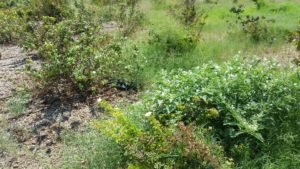 Peter: That doesn’t mean you shouldn’t wash it because a bird could’ve pooped on there. A dog could’ve, a tall dog could’ve… Even though it’s organic always wash your stuff.
Peter: That doesn’t mean you shouldn’t wash it because a bird could’ve pooped on there. A dog could’ve, a tall dog could’ve… Even though it’s organic always wash your stuff.
Kari: Still wash, yeah.
Peter: Plus, there’s a pile of manure back there from our veterinary tech large animal facility. You don’t want to just start eating stuff without washing.
Kari: You’re using the waste from the vet tech program as a resource here one the property.
Peter: Oh yeah, sure.
Kari: That’s great.
Peter: We’ve got some chillis that are doing really well.
Kari: Nice looking chillis.
Peter: Actually, these might be …
Kari: Well, they’re standing up.
Peter: They might be baby.
Kari: They’re not minding the Bermuda grass at all.
Peter: They’re sweet. What’s the name of that dwarf babybells? Babybells.
Learn to Farm at the MCC Teaching Farm
Here’s our urban farm, we’ve got this whole area to the north used to be a community garden. We’re shrinking the community garden down and we’re expanding our crop growing area at the urban farm. This semester we’re going to till this whole area and then this is already prepared. We solarized this whole area, we’re just starting to take back the black plastic now, what hasn’t already broken down. This has been solarized all summer and we’re going start to work this starting next week.
Over here, this is a rose trial. We’re trialing different rose varieties for no fertilizer usage, no pesticide usage, and very low water usage. Whoever makes it through this trial will go into our production mainly to work the Arizona area. Some of them are looking pretty good and they only get a half an inch of water a week.
Kari: Wow. That’s really good.
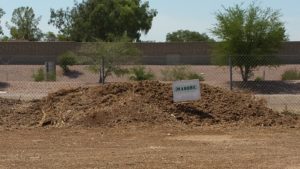 Composting
Composting
Peter: Down here, we have our composting area. We get our manure, then we mix it in with our plant waste. We just used up all of our windrow compost that was done, so we’ve already incorporated that in. We’re going to start taking this manure and then we’ll start a new windrow this season. That black stuff that’s actually Hickman farm’s.
Kari: Chicken manure?
Peter: That’s the chicken compost, yeah. That’s been purchased, I wish I could produce stuff as fine as that. All right, so let’s see. What else we got out here? I guess we can take a look at what some of what’s made it through the summer. Like I said, being a teaching garden, we’ve got different challenges than your typical urban farmer would have since our work force goes away in the summer time. Then so we really just have one of a sort of short window of opportunity for growing on.
Bermuda Eradication and Solarizing
We do teach students to follow planting calendars, follow proper crop rotations, so they can grow all year long. As you can see on the left, this is Bermuda grass that has sort of taken over. Since this has been taken care of over the years, that Bermuda grass is mainly spreading across the surface. We can pull that off and then that is really easily tilled and then raked out, versus if we had let it just go for years it would take forever to get rid of that.
Kari: It would grow deep.
Peter: That’s a lot easier. We don’t use plastic covering, except for solarizing. We just rely on hand cultivation, although we do have some tillers. We’ll till it once and then for the rest of the year we just get in here with hand cultivators, a three-pronged cultivator or a hula hoe.
Irrigation Techniques
We irrigate with drip and we have an old system that we just sort of cobbled together when I put this farm together a couple of years ago. We’re starting a brand new system now, we had a pretty high tech system designed. We’re going to be replacing the clock over there with a sort of higher level smart irrigation system. We’re going to have soil moisture sensors and we’ll be irrigating more so just on the clock than when the plants really need it. We can measure when the soil moisture levels drop to a certain level we’ll start irrigating. Then when they get to a certain level we can stop irrigating.
We can also track that data for future usage in the classes since we are an educational institution.
Kari: Right, that’s so important to practice water conservation and be economical with our water usage.
Water Conservation Tools
Peter: Absolutely, and for not a whole lot of money you can build your own system with stuff that you can purchase online. You can get two irrometers, it’s a long tube with a ceramic end and then you fill it with the liquid and you pump it up and it has a pressure gauge. You’ll have one at your root level, then you’ll have one deeper. When the one that’s deeper senses enough water, that means that it’s been irrigated deeply enough. When the one that’s higher up gets dry, that means that it’s dry, that means it’s time to put on some more. They’re not a whole lot of money, I mean, they’re not cheap.
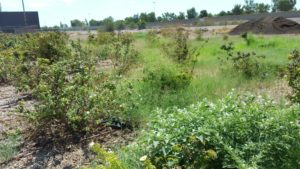 Kari: Probably end up saving you a lot of money in the long run.
Kari: Probably end up saving you a lot of money in the long run.
Peter: It will save you a lot of money in water too. I highly recommend the drip irrigation. It’s a little bit of money up-front to start with but you’ll save a lot of water. You’ll save a lot more in evaporation, since of course if you’re sprinkling, that’s most wasteful out here in the desert.
If you’ve got flood irrigation, and you’ve got that already in your property, well use what you have but a drip is an awesome addition.
Kari: Most people don’t have (flood) irrigation anymore. A few of the lucky ones, right, for the trees.
Crop Protection
Peter: If you turn around, you see that pile of white PVC.
Kari: Yes.
Peter: White structures. Those are little teepees that we put down over the roses and we cover our taller crops with them. With the shorter crops we put that really thin, white, floating row cover down. That helps to keep a lot of insects away, but also provides a bit of shade for our new transplants. The only trouble with floating row cover is it keeps insects out so, if we’ve got a crop that needs pollinating, you do need to pull it back and get in there.
Kari: Do you do that in the morning, or what time of day?
Peter: Whenever we’ve got students.
Kari: Whenever you’ve got students, OK.
Peter: Preferably in the morning when it’s tolerable for you to be out here, but in the winter when most of our crops are growing it’s beautiful out here all day long. I would much rather work at noon in December than at 5am.
Kari: Yeah, it’s dark.
Peter: That’s right, in December it’s probably dark until 7am.
Farm Education Concerning Sustainable Farming and Climate Challenges
Kari: What do you think is the biggest challenge to growing here in Maricopa County?
Peter: Water availability, water costs, water’s not too expensive yet but that’s going to change. For those of you following the trends, following the news, we’re in the middle of a crisis and it’s getting worse. Water, labor, just getting people out here to work, and heat.
If you follow the best practices, you could farm all year long, you can make a living. It just takes a lot more practice, it takes more research, and just getting out there really, really early in the morning. Like you know, come 10 or 11 o’clock, you’re dying.
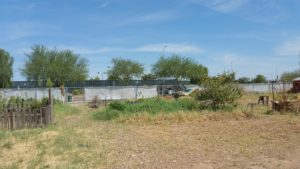 Kari: It’s very hot. Very hot right now. You told me about how water, how you’re upgrading your water system to make that more economical, and you get out here early with the students then? Do students want to learn to farm in the heat?
Kari: It’s very hot. Very hot right now. You told me about how water, how you’re upgrading your water system to make that more economical, and you get out here early with the students then? Do students want to learn to farm in the heat?
Peter: Yes, we try to start, when it’s hot like this we try to start, I’ve tried 6am that’s too early. 7am.
Soil Building
The other thing that I didn’t mention is our desert soils, which people think aren’t good. Our desert soils are good, they just need organic materials, so our compost, the manures, just keep on adding organic material and our soil … I mean this …
This is a soil in Phoenix, and we have been amending it for years with organic material. You see the way it holds together nicely so it’s got a good enough clay content but it breaks off and so that indicates the proper amount of sand and silt. It’s dark and it smells great, so that indicates the organic material. This is a very, very productive soil.
Even now, in the heat of summer that basil looks lush and green. We never fertilize this, all we do is just add organic material every year, we till it in, and then plant. We never add fertilizer. We’ve never had problems with our plants looking yellow or not producing.
Organic Farming
Peter: We’ve never sprayed pesticides out here. Every now and again we may get a big attack of aphids or whitefly, but not too bad and if that happens we can pull the plants out if they’re too far gone and then start over again. Cut your losses.
Kari: No need to panic.
Peter: No. We’re in a unique situation in that I don’t have to make a profit here so I don’t want to trivialize pulling things out and throwing them away when that is your livelihood. If you have a good number of rotation of crops and if you don’t just have entire rows of the same plant, if you’ve got companion plantings, then if you do get a problem you can pull that plant out and still have other crops there that actually can (produce a harvest.)
Learn to Farm at MCC
Kari: Fantastic. This has been really a great tour. If someone wants to learn to farm and is interested in the programs here how do they get involved?
Peter: You can contact me peter.condon@mesacc.edu or you can go to our website mesacc.edu/cua for Center for Urban Agriculture and that will have links to the college programs. The sustainable agriculture program isn’t on there yet since it still has to be officially posted but you can sign up for classes in urban horticulture and once the sustainable agriculture is up you can slide right into that. Since the semester starts today it might be kind of late to sign up to sign up to classes anyway.
Kari: So think about that for next spring, and enroll at MCC to learn to farm.
Peter: We will see you in the spring, and if anybody has any questions please send me an email. Email is the best way to contact me, and I will look forward to meeting and farming with you.
Kari: Thanks Peter, appreciate it.
